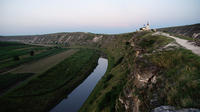Chisinau Old Orhei Excursion
Chisinau, Moldova
Trip Type: Day Trips
Duration: 6 hours
Old Orhei - one of the most remarkable monuments of the dim and distant past. On the eastern outskirts of the fully stocked wood, in a valley formed by cliff rocky banks of the river Reut, at the Cape Pestere ("cave"), it was the city of Old Orhei.
More About This Activity All Day Trips →
Old Orhei - one of the most remarkable monuments of the dim and distant past. On the eastern outskirts of the fully stocked wood, in a valley formed by cliff rocky banks of the river Reut, at the Cape Pestere ("cave"), it was the city of Old Orhei.The history of Old Orhei brings us back to the far back in the past - fifteenth century: reign of Stefan cel Mare. In the summer of 1470 it was finished the construction of the fortress on the rocky shore of Reut. The city's population was about two thousand inhabitants. In the early 70 of the XV century Orhei reached its greatest prosperity as a handicraft and trade center of Moldavian Principality. Artifacts that were found during excavations tell about the development of pottery, smithcraft, nailery, leather craft, Shoemaking, jewellery and other crafts. After the attack of the Crimean Tatars in 1499 and in 1510 respectively, Orhei was not able to restore, but attempts to revive the city were taken by hospodar Jeremiah Movila. However, already in 1603, 1633 years Orhei-called "old" or “ramshackle”.
Many scientists and lovers of antiques made great efforts to find the Old Orhei, because after its destruction, no one knew where there was this town. In 1947, the first expedition of archaeologists under the direction of G.D.Smirnov to Cape Pestere allowed to determine where Old Orhei was. During 20 years, it has been found more than 200 installations: workshops, storage rooms, cellars, houses, tools, coins, and many others. But as it turned out, Old Orhei is not the most ancient settlement that existed in this place.
In the late 30's - early 40 of XIII century, upon the Europe descended the Tatar-Mongol hordes. They had reached the coast of the Adriatic Sea. Golden Horde khans duly appreciated the advantageous location of Cape Pestere and built a great town with two caravans, mosque, baths-hauses, and water supply system. There were minted money. The city has received the name of Shehr-al-Jadid ("New Town") and became the center of the western part of the Golden Horde during the reign of Abdullah Khan in 1364.
Such is the brief history of Cape Pestere, Shehr-al-Jadid, Old Orhei – the town, that knew periods of growth and prosperity, experienced the dark days of fall. But this story would be incomplete without a visit to the peasant dwellings of eighteenth and nineteenth centuries, where you will told about the history of carpet weaving, folklore and everyday life of the peasants, but an amazing legend "On a golden carriage", closely interweaves fiction and reality of what was happening.
Many scientists and lovers of antiques made great efforts to find the Old Orhei, because after its destruction, no one knew where there was this town. In 1947, the first expedition of archaeologists under the direction of G.D.Smirnov to Cape Pestere allowed to determine where Old Orhei was. During 20 years, it has been found more than 200 installations: workshops, storage rooms, cellars, houses, tools, coins, and many others. But as it turned out, Old Orhei is not the most ancient settlement that existed in this place.
In the late 30's - early 40 of XIII century, upon the Europe descended the Tatar-Mongol hordes. They had reached the coast of the Adriatic Sea. Golden Horde khans duly appreciated the advantageous location of Cape Pestere and built a great town with two caravans, mosque, baths-hauses, and water supply system. There were minted money. The city has received the name of Shehr-al-Jadid ("New Town") and became the center of the western part of the Golden Horde during the reign of Abdullah Khan in 1364.
Such is the brief history of Cape Pestere, Shehr-al-Jadid, Old Orhei – the town, that knew periods of growth and prosperity, experienced the dark days of fall. But this story would be incomplete without a visit to the peasant dwellings of eighteenth and nineteenth centuries, where you will told about the history of carpet weaving, folklore and everyday life of the peasants, but an amazing legend "On a golden carriage", closely interweaves fiction and reality of what was happening.
« Go Back

